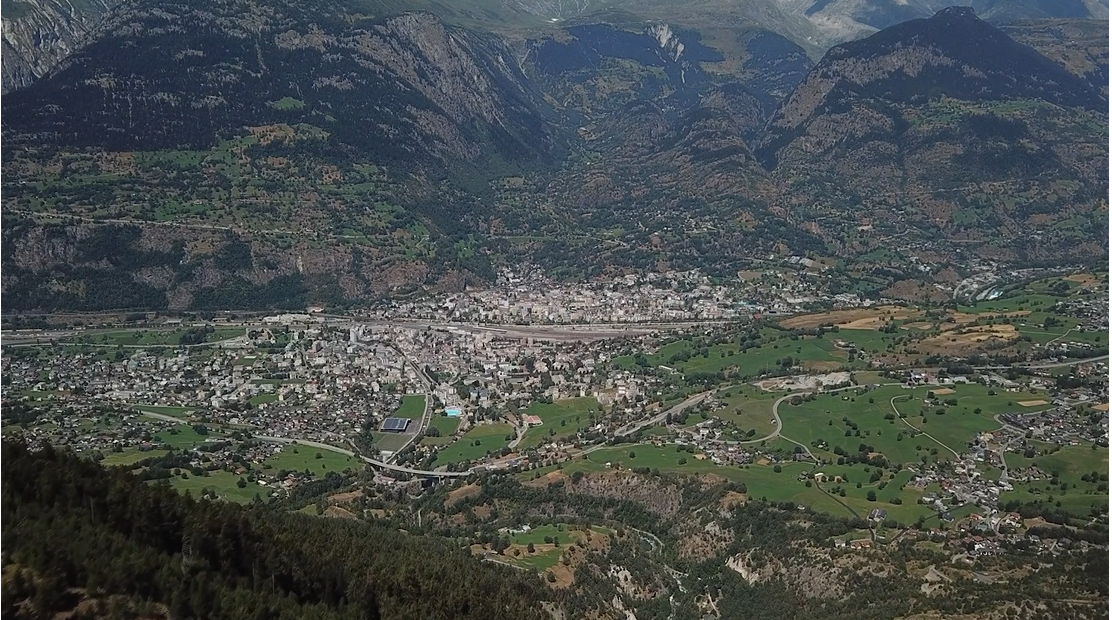A Master's student in architecture named Olivier Lalancette from École polytechnique fédérale de Lausanne (EPFL) has invented a few development proposals for the Brig-Visp-Naters conurbation.

Image Credit: École polytechnique fédérale de Lausanne
Lalancette’s proposals, comparatively modest in scope, could assist these cities in better resistance to heavy rainfall and the droughts that are anticipated to strengthen by 2050. Lalancette believes his study will begin a conversation regarding the region’s future.
Switzerland is known to be susceptible to intense weather events that are caused due to climate change, at present and also in the future. MeteoSwiss has cautioned that if greenhouse gas emissions do not come down by 2050, temperatures could increase by 2.3 °C to 4.4 °C in summer and 1.8 °C to 3.3 °C in winter. Mountain regions are anticipated to experience more considerable temperature increases compared to other areas.
In an average summertime, rainfall could reduce by 20% in the country, resulting in lengthy periods of drought—similar to what was noted in the summer of 2022. In the winter season, it is possible for precipitation to increase by 25%, yet snow will turn out to be highly exceptional.
Resilience and Well-Being
The study questions how Swiss cities with a strong industrial past, impenetrable surfaces, and few public spaces can be remodeled quickly so that they are set for heavy rainfall and droughts. What role could be played by architects in land-use planning and risk-prevention regions that have, so far, been dealt with primarily by civil engineers?
For his Master’s project, Lalancette determined two sites, both situated in grasslands, where these difficulties could be fulfilled. He makes use of the sites to display how urban areas could be made highly livable by getting various elements together that the land has to offer.
Lalancette’s two sites are situated in Haut-Valais: one in Brig and the other at a former Lonza disposal area. His recommendations are planned to make such areas highly strong and ideally suited to extreme weather events. Also, this could be done while enhancing public spaces and the well-being of the people surviving there.
Lalancette spoke to various experts at the time of his initial research. This included Tony Arborino, the engineer behind the third Rhône River course correction, and the project managers for the Brig-Visp-Naters conurbation. It was done to have a better insight into the context in which his concepts would be applied.
Three Changes in Brig
In Brig, Lalancette first indicates making the ground highly pervious to rain by constructing a bioswale together with a railway track to which trains will be redirected. This would make a runoff area for gathering water that can be infiltrated back into the groundwater table and soil.
Also, Lalancette indicates spanning a parking lot with trees and laying gravel on the ground. This was done again, keeping the goal of absorbing heavy rainfall in mind. In the second phase, the researcher suggests repurposing neighboring, partly empty buildings into community spaces.
Lalancette feels that part of the city center could be converted into an ecological corridor, which would better link the city to agricultural areas. Lalancette observes that the addition of trees and permaculture zones would restrict the heat-island effect and make a refuge for city dwellers during the time of hot weather.
As far as a residential area in the south of the city is concerned, Lalancette suggests substituting asphalt with an absorbent material and setting the stage for various spaces to encourage residents to converge with one another.
My suggestions show that improvements can be made. I’m hoping to start a conversation.
Olivier Lalancette, Architecture Graduate, École polytechnique fédérale de Lausanne
Ecological and Pedestrian Connections
What if one of Switzerland’s highly contaminated sites was to become a haven for biodiversity? Keeping this idea in mind, Lalancette defined possible redevelopment plans for a former landfill site in Gamsenried. The site measuring around 290,000 m2 lies between Visp and Brig and is presently being remediated by Lonza via a process that will take numerous decades.
As soon as the remediation work is done, Lalancette recommends planting a range of heat-resistant tree species and summing pedestrian and bike routes to promote people to cycle between Visp and Brig.
My ideas are still hypothetical since the land here is very complicated. But my suggestions show that improvements can be made. I’m hoping to start a conversation.
Olivier Lalancette, Architecture Graduate, École polytechnique fédérale de Lausanne
Ski Resorts Become Forests
Climate change will force us to repurpose some of the infrastructure that already exists in our regions.
Olivier Lalancette, Architecture Graduate, École polytechnique fédérale de Lausanne
In concrete terms, to decelerate water flow and avoid soil erosion, city planners might need to plant trees responsible for renaturalizing riverbeds and disused ski slopes in times of drought to make use of dam water for purposes excluding power generation.
“These are not controversial ideas in our industry, even if they seem like huge changes that will impact lots of people,” Olivier concluded.
Un urbanisme adapté aux événements extrêmes pour le Haut-Valais
Video Credit: École polytechnique fédérale de Lausanne.